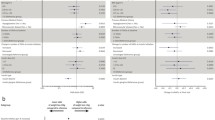Summary
Secondary failure of oral hypoglycaemic agents raises the dilemma of whether to institute therapy with insulin alone, or in combination. We reviewed our experience of combination therapy following secondary failure of oral hypoglycaemic therapy. Seventeen subjects were receiving combination therapy for 6 months or more. Such treatment was associated with a significant fall in HbA1C — from 10.7±0.38 per cent to 8.3±0.35 per cent (p<0.01) after 6 months and remained significantly reduced at 12 months (8.7±0.34 per cent (p<0.01)). Mean body weight, systolic and diastolic blood pressure were unchanged during treatment with adjuvant insulin therapy. Insulin therapy is a useful adjunct in the daily management of subjects with NIDDM who experience secondary failure of oral hypoglycaemic agents.
Similar content being viewed by others
References
Riflkin, H. (Ed): The Physician’s Guide to Type II Diabetes (NIDDM): Diagnosis and Treatment. New York, American Diabetes Association 1984: 21–52.
Groop, L C. Sulphonylureas in NIDDM. Diabetes Care 1992; 15: 737–754.
Varsano-Aharon, N., Echemendia, E., Yalow, R. S. Early insulin responses to glucose and tolbutamide in maturity-onset diabetes. Metabolism 1970; 19: 409–413.
Lebovitz, H. E. Oral Hypoglycaemic Agents. In: The Diabetes Annual Vol. 3. Alberti, K. G. M. M., Krall, L. P., Eds. New York, Elsevier, 1987:72–93.
Beck-Nielsen, H., Hother-Nielsen, O., Pedersen, O. Mechanism of action of sulphonylureas with special reference to the extra-pancreatic effect: an overview. Diabetic Medicine 1988; 5: 613–620.
Stumvoll, M., Nurjhan, N., Perriello, G., Dailey, G., Gerich, J. E. Metabolic effects of Metformin in NIDDM. New Engl. J. Med. 1995; 333: 550–554.
Pugh, J. A., Wagner, M. L., Sawyer, J., Ramirez, Tuley M., Friedberg, S. J. Is combination sulphonylurea and insulin therapy useful in NIDDM patients? a meta-analysis. Diabetes Care 1992; 15: 953–959.
Barnett, A. H., Bowen Jones, D., Burden, A. C., Janes, J. M., Sinclair, A., Small, M., Tindall, H. Multicentre study to assess quality of life and glycaemic control of Type 2 diabetic patients treated with insulin compared with oral hypoglycamic agents. Practical Diabetes International 1996; 13: 179–183.
Clauson, P., Karlander, S., Steen, L., Efendic, S. Daytime glibenclamide and bedtime NPH insulin compared to intensive insulin treatment in secondary sulphonylurea failure: a 1 year follow-up. Diabetic Med. 1996; 13: 471–477.
Chow, C. C., Tsang, L. W. W., Sorensen, J. P., Cockram, C. S. Comparison of insulin with or without continuation of oral hypoglycaemic agents in the treatment of secondary failure in NIDDM patients. Diabetes Care 1995; 18: 307–314.
Klein, R. Hyperglycaemia and microvascular and macrovascular disease in diabetes. Diabetes Care 1995; 18: 258–268.
Chase, H. P., Jackson, W. E., Hoops, S. L., Cockerham, R. S., Archer, P. G., O’Brien, D. Glucose control and the renal and retinal complications of insulin-dependent diabetes. J. Amer. Med. Assoc. 1989; 261: 1155–1160.
The Diabetes Control and Complications Trial Research Group. The Effect of intensive insulin treatment of diabetes on the development and progression of longterm complications in insulin dependent diabetes mellitus. New Engl. J. Med. 1995; 329:977–986.
Nelson, R. G., Gohdes, D. M., Everhart, J. E., Hartner, J. E., Zwemer, F. L., Pettitt, D. J., Knowler, W. C. Lower-extremity amputations in NIDDM: 12 year follow-up study in Pima Indians. Diabetes Care 1988; 11: 8–16.
Lee, J. S., Lu, M., Lee, V. S., Russell, D., Bahr, C., Lee, E. T. Lower-extremity amputation: incidence, risk factors, and mortality in the Oklahoma Indian Diabetes Study. Diabetes Care 1993; 42: 876–882.
Schade, D. S., Mitchell, W. S., Griego, G. Addition of sulphonylurea to insulin treatment in poorly controlled Type II diabetes. J. Amer. Med. Ass. 1987; 257: 2441–2445.
Lawrence, A. M., Abraira, C. New modalities in diabetes treatment. Am. J. Med. 1988; 85: 153–158.
Casner, P. R. Insulin-glyburide combination therapy for MDDM: A longterm double-blind, placebo-controlled, trial. Clin. Pharmacol. Ther. 1988; 44: 594–603.
Soneru, I. L., Agrawal, L., Murphy, J. C., Lawrence, A. M., Abraira, C. Comparison of morning or bedtime insulin with and without glyburide in secondary sulphonylurea failure. Diabetes Care 1993, 16: 896–901.
Author information
Authors and Affiliations
Rights and permissions
About this article
Cite this article
Griffin, M.E., Black, N., Giblin, L. et al. Efficacy of combination therapy in non-insulin dependent diabetes mellitus. I.J.M.S. 166, 260–262 (1997). https://doi.org/10.1007/BF02944248
Issue Date:
DOI: https://doi.org/10.1007/BF02944248




